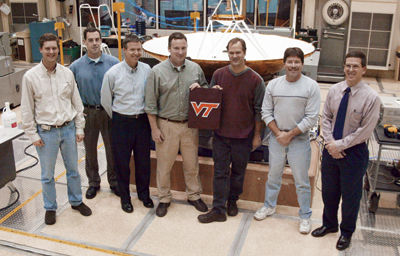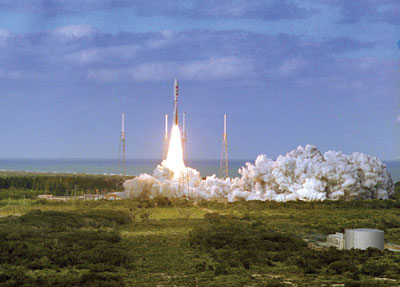|
 Forging toward a final frontier Forging toward a final frontier
by Sherry Bithell
|
It reads like a sci-fi novel: The Atlas V rocket blasted into space at 36,256 mph, the fastest space launch ever. On board was a piano-sized spacecraft--bristling with new technology tested by the finest scientific minds--that awaited the end of a 3 billion-mile, nine-year mission, when it would explore a previously unseen world....
But this story is not science fiction--it's the result of several alumni putting their heads together to create innovative systems that led to the Jan. 19 launch of the New Horizons spacecraft from Cape Canaveral, the first of many steps in what will be an epic journey.
|
|
Problem solving at its finest
The New Horizons mission was planned to help NASA answer some basic questions about the surface properties of Pluto and the mini-worlds of the Kuiper Belt. After swinging past Jupiter for a gravity boost next February, New Horizons will travel farther into space until July 2015, when it will conduct flyby studies of Pluto--the last planet in our solar system to be visited by spacecraft--and its largest moon, Charon. If NASA extends the mission, the spacecraft will then continue into the Kuiper Belt to study other mini-worlds. Overall, New Horizons will journey billions of miles and perform studies for at least the next decade, if not beyond.
|
XX |
|
Planning and implementing a mission of such distance and duration is a great challenge, and the task fell to a mission team largely comprised of Hokies at The Johns Hopkins University's Applied Physics Laboratory (APL) in Laurel, Md. APL conducts research for a number of government agencies, including NASA, and has built and operated more than 60 spacecraft.
To solve the spacecraft's power constraints, the team devised a low-power, deep-space digital receiver, called "a key enabling technology for the mission" by Bob Bokulic (electrical engineering '81), supervisor of the Radio Frequency Group at APL. Because of the great distance New Horizons will travel from the Sun, the spacecraft cannot rely on solar panels for energy. Instead, power is being generated by a radioisotope thermoelectric generator (RTG) and is limited to 200 watts at Pluto, about the power in two household light bulbs. The digital receiver effort, led by Chris Haskins (electrical engineering '97; M.S. '00), resulted in technology that consumes 60 percent less power than other deep space receivers.
"The 15 watts saved by Haskins' receivers is a substantial amount," Bokulic says. "To give you an idea of the impact, 15 watts is approximately equal to the total power of the science instruments on-board."
Another challenge facing the mission was finding a way to communicate with the spacecraft when it is billions of miles away, a job that fell under the auspices of Chris DeBoy (electrical engineering '90), telecommunications lead engineer for the mission. DeBoy oversaw the team's efforts to put together a system that meets mission requirements for communications link performance, radio science, and spacecraft tracking. "Basically, I make sure we can get commands to the spacecraft and bits back from it," DeBoy says.
|
New Horizons team members

 From left, Chris Haskins '97, '00; Chris Fry '96; From left, Chris Haskins '97, '00; Chris Fry '96;
Bob Bokulic '81; Chris DeBoy '90; Ron Schulze '90;
Jeff Will; and Kevin Ailinger '89 pose in front of the
Pluto-bound spacecraft's 83-inch dish antenna.
|
XXX |
Of course, innovation cannot be taken on faith--enter Chris Fry (electrical engineering '96), who at the time worked for ASRC Aerospace, a contractor that develops testbed hardware. As the lead engineer for the New Horizons simulator, Fry oversaw the testing of the spacecraft simulator's command and data interfaces and hardware. "This step, and the importance of having identical hardware--or simulated hardware--on the ground, are critical to ensuring commands are processed and executed properly," explains Fry. "You wouldn't want to uplink a new routine that controls, for example, thruster firing duration or power conditioning for the computer before you have a chance to simulate its effects."
The ingenuity didn't stop there; DeBoy notes that the team devised several "unique capabilities on the New Horizons telecommunications system. We're the first to fly regenerative ranging on a deep space mission and the first to use an uplink radio science experiment for deep space remote sensing." These new technologies will not only help NASA track the progress of New Horizons but also can be employed in future missions.
|
Up, up, and away
| X |
Mission timeline
|
January 2006
|
 |
launch |
|
February 2007
|
 |
Jupiter gravity assist
|
|
March 2007-June 2015
|
 |
interplanetary cruise
|
|
July 2015
|
 |
Pluto-Charon encounter
|
|
2016-2020
|
 |
Potential Kuiper Belt object encounters
|
|
|
|
XX |
Although New Horizons is gone, by no means has it been forgotten. In addition to having overseen the integration and testing of the spacecraft, Andy Good (aerospace and ocean engineering '79) will supervise the mission operations team that will control and monitor all spacecraft activity for the duration of the mission, including guiding it past Jupiter and on to Pluto and beyond.
DeBoy also will be responsible for numerous tasks for the duration of the mission, including operating the telecommunications system; verifying data rate capabilities; monitoring the performance of the radios, antennas, and oscillators for any subtle degradations; and conducting tests for telecommunications and radioscience experiments.
"This first year, between launch and the Jupiter flyby in February 2007, will be busy with system checkout and testing," says DeBoy. After New Horizons passes its Jupiter milestone, he adds, "there will be significant periods of time where the spacecraft is placed in 'hibernation,' safely and slowly spinning while pointed towards Earth, phoning home once a week. We'll wake it up and give it a thorough checkout at least once a year, so support on the mission will ebb and flow."
As the spacecraft gets within a year of its Pluto flyby, DeBoy says, activity will gradually build again. In the meantime, although the team "will always be keeping an eye on New Horizons," its members will be busy with other satellite projects. Good, for instance, is currently overseeing the missions of four operational spacecraft and planning for a fifth that will launch later this year; called STEREO (Solar-TErrestrial RElations Observatory), it will provide a new perspective on solar eruptions and their consequences for Earth.
Although Fry has since left ASRC Aerospace, he says he plans to keep up regularly with the New Horizons mission, adding that he hopes to be invited to "the after-party I'm sure the team will throw in 2015 after New Horizons completes its tour of Pluto/Charon."
Now, that's some long-term planning.
Hokies on the Horizons
Kevin Ailinger (mechanical engineering '89) | guidance and control system developer
Joe Bogdanski (electrical engineering '80) | flight solid state recorder lead engineer
Bob Bokulic (electrical engineering '81) | supervisor of the Radio Frequency (RF) Engineering Group at APL
Chris DeBoy (electrical engineering '90) | telecommunications lead engineer
Chris Fry (electrical engineering '96) | spacecraft simulator developer, RF switch assembly engineer
Andy Good (aerospace and ocean engineering '79) | supervisor of spacecraft integration and operations
Matthew Grey (electrical engineering '00) | flight hardware designer for the long-range reconnaissance imager (LORRI) instrument
Chris Haskins (electrical engineering '97; M.S. '00) | low-power digital receiver engineer
John Hayes (electrical engineering '82) | flight software engineer for the LORRI instrument
Ron Schulze (electrical engineering '90) | satellite antennas engineer
Marsha Schwinger (aerospace and ocean engineering '94) | guidance and control team
Josh Steele (physics '97; M.S. computer science '02) | instrument software engineer
John Troll (engineering science and mechanics '97) | flight alignments lead engineer
|
|


